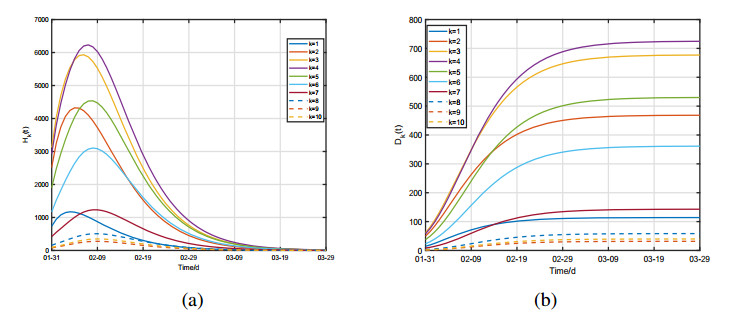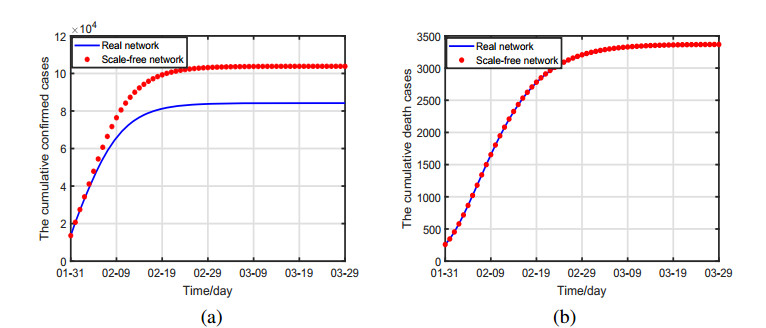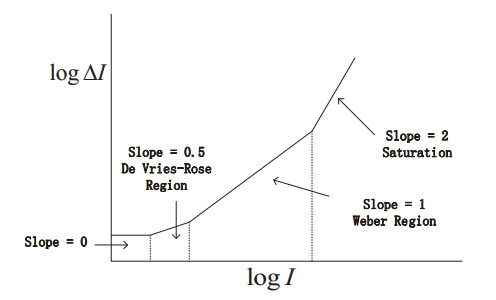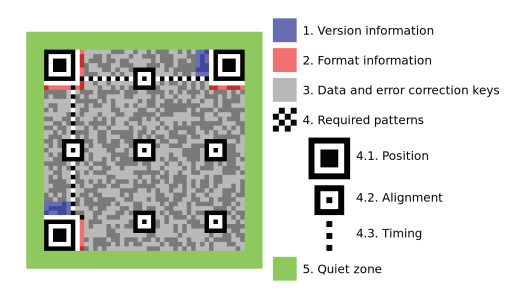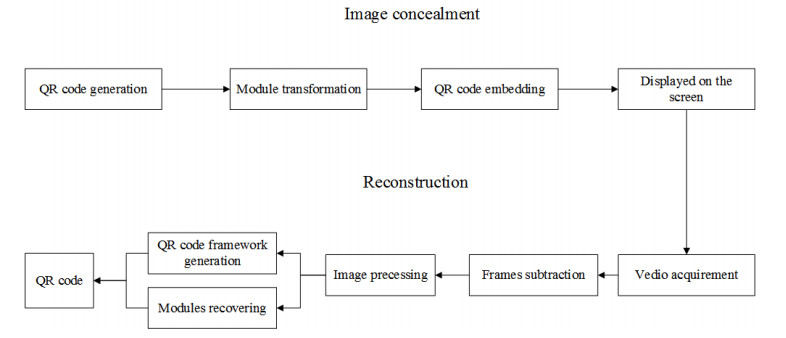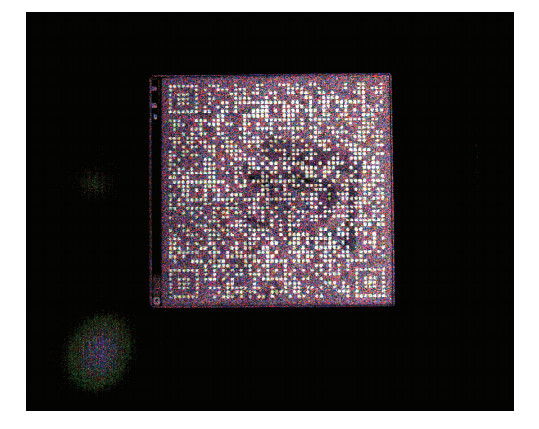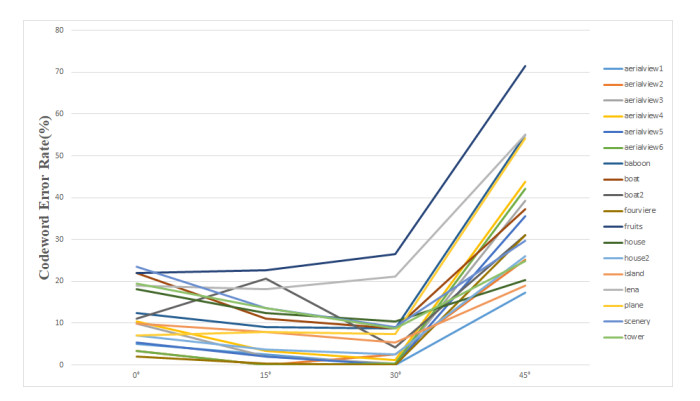In recent years, many methods of exfiltrating information from air-gapped systems, including electromagnetic, thermal, acoustic and optical covert channels, have been proposed. However, as a typical optical channel, the screen-camera method has rarely been considered; it is less covert because it is visible to humans. In this paper, inspired by the rapid upgrades of cameras and monitors, we propose an air-gapped screen-camera covert channel with decreased perceptibility that is suitable for complex content. Our method exploits the characteristics of the human vision system (HVS) and embeds quick response (QR) codes containing sensitive data in the displayed frames. This slight modification of the frames cannot be sensed by the HVS but can be recorded by the cameras. Then, using certain image processing techniques, we reconstruct the QR codes to some degree and extract the secret data with a certain level of robustness due to the error correction capacity of QR codes. In the scenario to which our method applies, we assume that a program has been installed in the target system and has the authority to modify the frames without affecting the normal operations of valid users. Cameras, such as web cameras, surveillance cameras and smartphone cameras, can be receivers in our method. We illustrate the applicability of our method to frames with complex content using several different cover images. Experiments involving different angles between the screen and the camera were conducted to highlight the feasibility of our method with angles of 0°,15° and 30° .
1.
Background
A novel coronavirus disease 2019 outbreak, caused by the severe acute respiratory syndrome coronavirus and named SARS-Cov-2, has now spread to more than 200 countries and administrative areas [1]. Most of infected individuals exhibit pneumonia-like symptoms similar to SARS in 2003 and Middle East respiratory syndrome (MERS) in 2013. SARS-Cov-2 virus is primarily transmitted by direct contact with infected people and indirect contact with surfaces in the immediate environment or with objects used by the infected persons. The SARS-Cov-2 emerged in Wuhan, a center city of mainland China in December of 2019. As of March 13th, more than 80 thousands individuals infected by SARS-Cov-2 have been confirmed and nearly 3.5 thousands deaths have been directly caused by SARS-Cov-2 [2,3]. These numbers across the globe are expected to rise with the ongoing disease.
Facing the emerging global health threat, the Chinese government enforced a series of containment strategies, such as city lockdown, traffic restrictions, household quarantine, close contact tracing, face masks etc., to curb SARS-Cov-2 transmission on January 22nd, 2020 [4]. Meanwhile, the mainland China raised the national public health response to the highest state of emergence, Level 1, defined as an "extremely serious evidence" [3,4]. Indeed, those mixed control measures and containments of SARS-Cov-2 had averted a huge number of confirmed cases, decreasing from 744,000 to 29,839 by February 19th [5]. The basic reproduction number had declined from 3.15 to 0.97 before and after those control strategies [5]. The travel restrictions delayed the overall epidemic progression by 3 to 5 days in mainland China [6]. In [8], non-pharmaceutical interventions in China reduced 7–8 fold of daily contacts since most of contacts restricted to the household. They found that the adolescents (0–14 years old) are less susceptible to SARS-Cov-2 infection than adults (15–64 years old). The effectiveness of these containment measures strongly depends on when they are enacted and the proportion of quarantine. However, these enacted containments had substantially changed the transmission pattern of SARS-Cov-2 prevalence in mainland China. Under such enforced control strategies, each family was allowed at most one member going outside for necessities. Therefore, individual contact pattern was approximated to be a contact pattern of inner family, which was closely related to the structures of households of mainland China [9]. How to study the effects of the household heterogeneities on the transmission pattern of SARS-Cov-2 plays a vital role in evaluation of those control measures and the intrinsic dynamics.
Undoubtedly, SARS-Cov-2 has drawn increased attention from mathematicians, biologists, and public health researchers across the globe. Many epidemiological models have been attributed to study the dynamics of SARS-Cov-2 infection and statistic analysis. Most of them have assumed that individual contacts are homogeneous [5,9,10,11,12,13,14]. As the mentioned above, they ignored the structures of households in mainland China. Additionally, under such extreme strategies, the susceptibility of SARS-Cov-2 was suddenly reduced and such a proportion is unclear. How to evaluate and identify such a value is important to understand the evolution of SARS-Cov-2 spread in mainland China. Furthermore, there are few publications considering the case fatality risk (CFR) to examine the severity of SARS-Cov-2 infection in mainland China. Based on a competing risk model, a crude CFR was estimated to be 7.24% (95% CI:6.68–8.01%) for Hubei province and 1% (95% CI:0.87–1.18%) for other provinces of mainland China [15].
In this study, we focus on two aspects: First, we introduce the household structures of mainland China to propose a mean-field model, considering the heterogeneities of individual contacts, to study the dynamics of SARS-Cov-2 infection on complex networks. Second, we identify the susceptibility of SARS-Cov-2 infection and explore the severity of SARS-Cov-2 transmission by inserting a quarantined susceptible compartment and a cumulative confirmed death compartment into the classical SEIR compartmental model. The aim of this paper is to investigate the intrinsic dynamics of SARS-Cov-2 infection and evaluate the public control measures impacted by the structure of households in mainland China.
2.
Materials and method
2.1. Data description and collection
We picked up the cumulative hospitalized data and death cases of SARS-Cov-2 from the National Health Commission of the People's Republic of China. Since the definition of confirmed cases was changed on February 12th, 2020-the clinically diagnosed cases had been counted in cumulative confirmed cases, we collected the data period from January 31st to March 31st. To obtain the relatively reliable data, we allocated the sudden increment on February 12th to each day in the preceding week in proportion to the original increments of daily documented cases in these days.
All the definitions of suspected cases, death-caused by SARS-Cov-2, hospitalized cases, cured cases were obtained from Chinese Control Disease Center and Prevention [3] (see Figure 1(a)). The households structure was taken from Chinese Population Statistic Yearbook [16] and their distributions were shown in Figure 1(b).
2.1.1. Model formulation
Based on the Chinese Population Statistic Yearbook 2019 [16], the structures of households are classified into ten types by the numbers of each household and its degree distribution p(k)=Nk/N is shown in Figure 1(b), where Nk represents the proportion of one family consisting of k members and N=∑10k=0Nk(t) denotes the total population. In order to address the effects of the household quarantine and self-protection, we divide the total subpopulation Nk(t) with degree k into seven different statuses: susceptible class, latent class with no transmission ability, infected class including latent individuals in the transmission phase, asymptomatic individuals and symptomatic individuals, recovery class, unsusceptible class, hospitalized class and cumulative death class, denoted by Sk(t), Ek(t), Ik(t), Rk(t), SQk(t), Hk(t) and Dk(t), respectively. The subscripts denote the degree of associated nodes. The susceptible individuals are infected by infected individuals and then changed the state as the exposed; the susceptible individuals who are isolated or exercising self-protection become unsusceptible at rate α. The exposed individuals have become infected individuals after 1/q days periods. The infected individuals are diagnosed as hospitalized individuals at rate λ. The hospitalized individuals are cured and become recovered individuals at rate γ, and succumb to the virus and move into the death class at rate d. The above transformation of states are governed in the following equations:
where
denotes the probability of any chosen edge connecting to an infected individual at time t, and ⟨k⟩=10∑k=1kp(k) is the average degree. Furthermore, we assume that model (2.1) has the following initial values
and
Summing up all the equations of (2.1) yields dNk(t)dt=0, which implies that Nk(t)=1. The biological means of model parameters and their values of model (2.1) are enclosed in Table 1. Table 2 gives the initial data of model (2.1). Apparently, model (2.1) has a unique disease-free equilibrium
With the help of the approach in [17], linearizing model (2.1) at the disease-free equilibrium P0, we calculate the basic reproduction number of model (2.1) in form of
where ⟨k2⟩=∑10k=0k2p(k) denotes the two movement of the degree distribution of p(k).
The monotonicity and continuity of system (2.1) ensure that Sk(∞)→Sk∞, Ek(∞)→0, Ik(∞)→0, SQk(∞)→SQk∞, as t→+∞. Solving Sk,Ek,Ik and SQk equations of system (2.1), we obtain that
where T stands the duration of SARS-Cov-2.
Let IkTp denote the peak value of infected individuals at time Tp. Similar to (2.4), the peak value satisfies the following equation:
where SkTp and SQkTp represent proportions of susceptible nodes and unsusceptible nodes at peak arrival time Tp.
The details for deriving equations (2.4) and (2.5) are enclosed in the Appendix.
3.
Results
Since the Chinese government has enacted a series of containment strategies, including traffic restriction, household quarantine, and close contact tracing etc., at most one member of each family was allowed to go outside for necessaries during those days. The pattern of contacts was approximated to be a household-to-household network (a real network), which is definitely determined by the structures of the households of the mainland China with the minimum degree 1, the maximum degree 10, and the average degree ⟨k⟩=2.75; A scale-free network is a configure network with the minimum degree 1, the maximum degree 12, and the average degree ⟨k⟩=4.07.
According to the cumulative number of confirmed cases reported by the National Health Commission of the People's Republic of China from January 31st to March 31st [2], we adopted Markvo Chain Monte Carlo method, together with Metropolis-Hastings (MH) algorithm to fit the model and identified the model parameters. The maximum likelihood function for the data set C={CI(t),CD(t)}60t=0 from January 31st to March 31st is
where
and
The small perturbations ϵj(j=I,D) satisfy normal distributions N(0,σj)(j=I,D) with σI=1000 and σD=100 making data fall in a rational region and enabling the iterations converge within a relatively short period. P denotes the vector of model parameters.
Proceeding the MCMC numerical method running for 20,000 iterations with a burn-in of 11,000 iterations, we employed the identification parameters and Eq (2.3) to calculate the basic reproduction number R0=2.05 (95% CI [1.38, 2.87]), which was close to the value reported in [11]. The peak value of documented ill patients of SARS-Cov-2 was approximated to be 29766 (95% CI [29734, 29868]) on February 7th (95% CI [Feb. 4th, Feb. 10th]). Furthermore, we predicated that the final size was approximated to be 94055 (95% CI [94050, 94059]) at the epidemic duration of 101 days (95% CI [96,104]).
A good-fitting of clinical data and the solution of model are shown in Figure 2. Overall, the epidemic trends of the documented cases and death cases were correlated well with the trends of the model solution and final trends completely fell in a 95% confidence interval of the solution of model (2.1). To further calibrate the rationality of model (2.1), we applied reported cumulative cases from April 1st to 15th to validate the fitting effects on the solution of model (2.1). Figure 2 shows that cumulative clinical cases are very consistent with the overall trend of the model, and the fifteen validated points also fell in a 95% confidence interval of the solution of model (2.1). All the results of Figure 2 illustrate that model (2.1) successfully addresses the epidemic trend of SARS-Cov-2 in mainland China. On the contrary, Figure 3 displays the epidemic trends of diagnosed cases and deaths caused by COVID-19 in each household of mainland China. We noted that the largest numbers of diagnosed cases and deaths were the family of four; the earliest arrival peak of hospitalized cases was the one-person household. All of these suggested that the greater the household degree distribution and the higher the risk of infection.
In what follows, we studied the household pattern of SARS-Cov-2 prevalence in mainland China on the strict isolation measures mentioned in Section 1. Doing such an issue was in favor of evaluating the effects of the control strategies. First, if the Chinese government didn't enact any extreme strategy, the individual contact networks can be considered as a scale-free network with the average degree ⟨k⟩=4.07 and the max degree of 12, which implies that one person may infect approximately 4 persons and at most contacts 12 persons per day. According to Figure 4, we found that the cumulative confirmed cases of SARS-Cov-2 may decrease nearly 25%, but the cumulative deaths had almost no any change, which mainly depends on the medical resources available. Furthermore, from Table 3, under the current strategies, it follows that the peak value shrank about 13% (95% CI [10%, 18%]), the peak arrival time delay 5 days with 95% CI [3, 5] days; the final size has enlarged almost 29%. However, the epidemic duration may advance nearly 2 days in a scale-free network.
4.
Discussion
In this paper, we established a mean field SARS-Cov-2 infection model based on a household-to-household network. The contact heterogeneity has been addressed by a certain degree distribution of households chosen from [16]. According to such model, we successfully captured the muti-dimensional data including cumulative diagnosed cases and deaths. Model (2.1) can be used to evaluate the effects of some containment strategies to mitigate SARS-Cov-2 prevalence in China, to some extent.
As we known, there are three primary kinds of modelling approaches, including mean-field model, pairwise model and edge-compartmental approach, to consider the relationship between two nodes on networks. For a pairewise model [9], [SSE] denotes the numbers of the triple with join structures S−S−E (S and E denote the states of susceptibles and the exposed, respectively), which can be approximated to be in form of
where the pairs of [SS] and [SE] stand for the numbers of links between susceptibles and susceptibles and the numbers of links between susectibles and the exposed, respectively. [S] denotes the numbers of susceptibles. For a mean-field model, [SkI] represents the numbers of links between susceptibles Sk with degree k and infectives I, which can be expressed as follows
An edge-compartmental model considers all the pairwises as a whole variable by a probability generating function. The different approximated approaches have different concerns. Pairwise models mainly focus on the evolution of each pairwise; Edge-compartmental models primarily focus on the variation of each link; Mean field models are concerned with the evolution of each node with its associated degree. Actually, the contact pattern under household quarantine can be considered as a family-to-family contact, nor a person-to-person contact. Such transmission property can be described by a mean-field modelling approach. Therefore, more details about household transmission patterns were available from our work (see Figure 3).
The basic reproduction number plays a key role in the evaluation of emerging diseases. Generally, the disease will increase exponentially if R0 is greater than one, whereas it can be eradicated if R0 is less than one under some certain control measures. Borrowing (2.3), together with the identified parameters, we estimated that the basic reproduction number R0=2.05 is greater than one, which means that each infected individual will produce 2.05 secondary cases and SARS-Cov-2 will continue to spread in mainland China. We must mention that that our calculated value of R0 was closely correlated with collected data period. Moreover, compared with no control strategies, the value of R0 enlarged as a larger value, a great bigger than the current one. The overestimation of R0 was made up by the following two reasons: one is that the mean field model don't care about the contact correlation and enable its value bigger than one derived by the pairwise model; the other one is that the two movement of a scale-free network is sufficiently larger than its average degree. From (2.3), the value of R0 become larger than that one conducted by the pairwise modelling approach [9]. This manifests that the household quarantine measure has taken a great beneficial effects on slowing down SARS-Cov-2 spread in mainland China.
In view of Table 3 and Figure 3, we found that the transmission risk primarily depends on the degree distributions of households nor the household members. Under such control strategies, each household was only allowed one member to go outside for necessities and the contact exhibits a household-to-household pattern nor a person-to-person pattern. All of these suggests that the average degree of households determines the transmission risk of SARS-Cov-2 in mainland China. Indeed, the value of the average degree was approximated to be 2.75 for the current network, but it was to be 4.07 for a scale-free networks. Figure 3(a) reflects that the family of four has the highest transmission risk than those risks of other households.
Some evidence illustrates that the elderly and those with compromised immune systems are certainly more at risk of getting severe form of SARS-Cov-2. The case fatality rate (CFR), defined as the proportion of cases of a specified condition that are fatal within a specified time, is often used to examine the situation pertaining to SARS-Cov-2, as well as other diseases. By model (2.1), the CFR in mainland China was approximated to be 4.0% (95% CI [3.3%, 4.7%]), according with that expected value estimated in [18].
5.
Conclusion
The outbreak of emerging SARS-Cov-2 has caused more than three months and more than 2,000,000 confirmed cases and more than 140,000 death cases as of March 17th, across the globe. How to curtail SARS-Cov-2 outbreaks has been become an urgent issue. The Chinese government had enforced a series of containment strategies, such as household quarantine, traffic restriction, city lockdown etc., to curb the disease spread. Such extreme control measures substantially changed the transmission pattern of SARS-Cov-2 in mainland China. In this study, we employed a mean-field model to investigate the dynamics of SARS-Cov-2 on a household network in mainland China. By fitting the cumulative hospitalized data and death related data, the basic reproduction number was evaluated as R0=2.05 (95% CI [1.38, 2.87]), the peak value of SARS-Cov-2 was nearly 29766 on February 7th and the epidemic duration will maintain 101 days. Through the careful analysis, the highest risk household was identified as the family of four. Our results suggested that under the current restrictive control measures, the transmission risk was significantly lower than not implementing a control strategy. Our investigations provided a new insight into the transmission heterogeneities and evaluation the effects of containment strategies in detail for public health decision and policymakers.
Acknowledgments
This work was supported by the National Natural Science Foundation of China (Nos. 61573016, 61873154), Shanxi Scholarship Council of China (No. 2015-094), and the New Coronavirus (COVID-19) Prevention and Control Project of Shanxi Province (No. 202003D31011 / GZ).
Conflict of interest
The authors declare no conflict of interest.
Appendix
In the appendix, we focus on how to derive the final size and peak size by system (2.1). We assume that COVID-19 will die out at the duration T and arrive at a peak value at time Tp. The fractions of susceptible nodes, unsusceptible nodes, exposed nodes and infected nodes at the final time T or at the peak time Tp are denoted by SkT,SQkT,EkT,IkT or SkTp,SQkTp,EkTp,IkTp, respectively. First, summing up Sk,Ek,Ik and SQk equations for system (2.1) yields
Then integrating (5.1) from 0 to T, we have
Multiplying kp(k)/⟨k⟩ on both sides of (5.2) and summing up from 1 to 10, one obtains
Integrating the first equation of (2.1) from 0 to T, one derives that
Then plugging (5.3) into (5.4) leads to
Multiplying kp(k) and summing up from 1 to 10 again, we get
Doing the similar process as the above at the peak arrival time Tp, we have that
Observing that dIk(t)dt|t=Tp=0, we have that EkTp=λqIkTp. Substituting such a quantity into (5.7) results in
Remark 1. Since the fractions of exposed nodes and infected nodes are small, we assume that Sk0=1,Ek0=Ik0=SQk0=0. Therefore, Eqs (5.6) and (5.8) simplifies as Eqs (2.4) and (2.5).
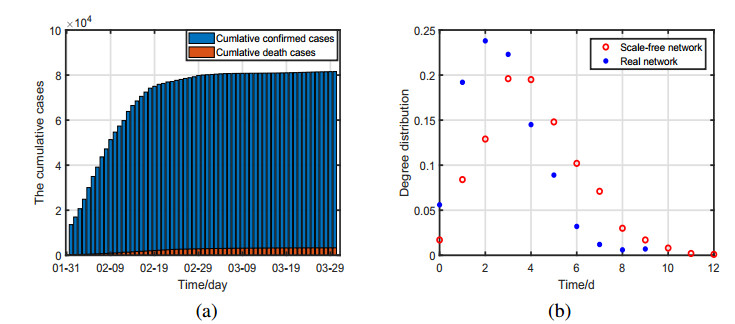









 DownLoad:
DownLoad:

